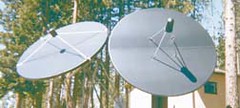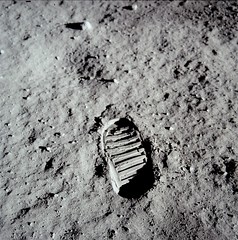Rumors have been going on for months about the two big U.S. satellite TV providers (DirecTV and EchoStar) merging. The buzz grew louder earlier this week after the Los Angeles Times quoted EchoStar CEO Charlie Ergen at the Allen & Company annual media-mogul-fest in Sun Valley, Idaho saying that combining the two largest satellite TV providers could save $3 billion in expenses.
The comment set off a renewed flurry of press speculation of a potential merger. The Rocky Mountain News (EchoStar is based in Englewood, CO) reported yesterday:
EchoStar Communications Corp. shares were raised to "buy" from "sell" at Citigroup Inc. because of an increased chance that the No. 2 satellite television provider may combine with rival DirecTV Group Inc….
"It reflects our belief that there is a greater chance that EchoStar and DirecTV may attempt to merge," Bazinet said
of his rating change.
A merger is more likely since EchoStar and DirecTV formed a joint venture to bid for wireless spectrum in an auction next month, Bazinet said in the note. Satellite TV companies are also facing rising competition from cable companies such as Comcast Corp. as well as from telephone companies such as Verizon Communications Inc. that are starting TV services.
Propelling the talk is the growing awareness that IPTV will fundamentally change the media landscape and the balance of power between satcom- and telco-delivered content, as well as growing evidence that Rubert Murdoch’s News Corp is set to receive approval for a project that could create a national WiMAX network. As The Hollywood Reporter writes:
Approval is imminent for the project that could take at least two years and $2 billion, providing News Corp. and DirecTV a valuable wireless interactive broadband loop with consumers to directly sell content, advertising, goods and services. WiMax is a wireless a broadband technology often referred to as "WiFi on steroids" with a much wider 30-mile range than the more limited access offered by WiFi services. WiMax, which is short for World Interoperability for Microwave Access, also promises to provide more security and speed than traditional wireless connections.
"If we can pull something off … there is no reason why that shouldn’t link in with everything," News Corp. chairman and CEO Rupert Murdoch said in a recent interview….
High-level sources say the unprecedented undertaking will involve strategic equity partners that bring WiMax spectrum, equipment and other expertise to the mix. In one of the most likely scenarios, News Corp. and DirecTV have been in advanced talks with Clearwire Corp., a WiMax venture of Craig McCaw, in which chipmaker Intel Corp. and equipment manufacturer Motorola Inc. recently invested $900 million.
McCaw has been amassing one of the largest stables of licensed radio spectrum to build his own national wireless WiMax network. Intel, which has a vested interest in the commercial success of WiMax, particularly for PC users, has been one of Clearwire’s partners from the start….
Some sources say that EchoStar could join DirecTV in providing a united domestic satellite-backed WiMax alternative to cable and to telephone competitors such as Verizon, Cingular and Sprint Nextel. Sprint Nextel is working with a consortium of cable operators including Comcast and Time Warner to assist them with a much-needed wireless out-of-home extension.
Still, not everyone is convinced that the coming WiMAX wars will lead to consolidation on the SatCom side. Al Lewis in the Denver Post says that "anybody who believes EchoStar and DirecTV are about to merge should remember the forgotten tome "The Essential Guide to the Echo- Star/DirecTV Deal:"
Australian media mogul Rupert Murdoch had his team of lobbyists canvass Washington with this 123-page diatribe in 2002.
It argued, in exhaustive detail, why Douglas County-based EchoStar should not be allowed to acquire DirecTV from Hughes Electronics….
In October 2002, the Federal Communications Commission [sic– it was the FTC] blocked Ergen’s deal. The Justice Department blocked it too.
Then Murdoch’s News Corp. acquired a controlling stake in DirecTV for $6.6 billion…
And now – four years later – there are continuing rumors that DirecTV, the nation’s No. 1 satellite-TV provider, will acquire EchoStar, No. 2.
EchoStar and DirecTV are working on several joint projects that involve the two-way transmission of voice, video and data. But if Murdoch were to bid on EchoStar, he’d have to argue against his previous arguments. Or he’d have to argue that the satellite-TV business has changed significantly over the past four years.
The results of the August auctions for additional WiFi spectrum will give observers a clue as to who is coming out ahead in the inevitable rush to bring WiMAX to market. And whether the DirecTV and EchoStar rumors are just rumors or not, we’d expect to hear more talk of consolidation on both sides as emerging technology further alters the old divisions between cable, satcom and telcos.
 Let’s face it: no matter how cool it may be to have a satellite dish, they make terrible lawn ornaments. Only the most hardy space nut finds the local neighborhood array a thing of beauty– and many homeowners associations have introduced covenants prohibiting the use of large dishes.
Let’s face it: no matter how cool it may be to have a satellite dish, they make terrible lawn ornaments. Only the most hardy space nut finds the local neighborhood array a thing of beauty– and many homeowners associations have introduced covenants prohibiting the use of large dishes. Most Home Owners Associations (HOA’s) have agreed that if the dish is adequately disguised, they will allow it. The ClearSat Umbrella Style Dish Cover will comply with most reasonable HOA’s by covering both the front and back, and when coupled with a set of chairs and table, can actually function as a patio set.
Most Home Owners Associations (HOA’s) have agreed that if the dish is adequately disguised, they will allow it. The ClearSat Umbrella Style Dish Cover will comply with most reasonable HOA’s by covering both the front and back, and when coupled with a set of chairs and table, can actually function as a patio set. 








